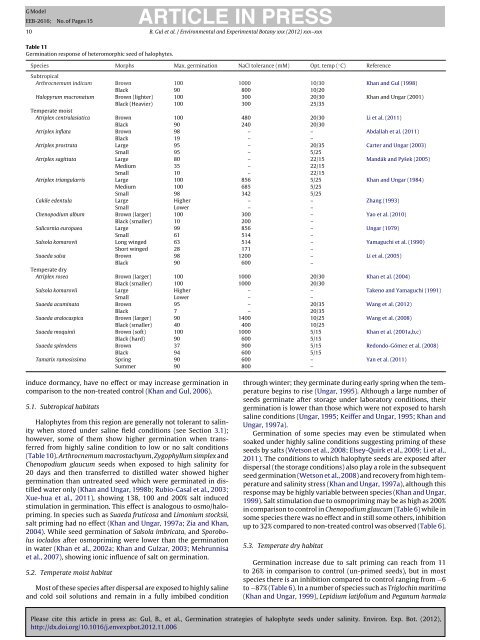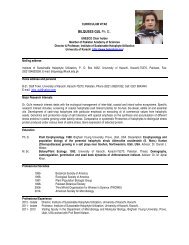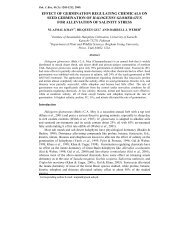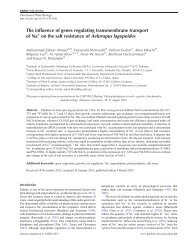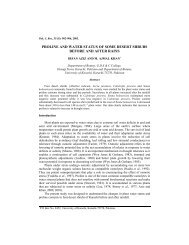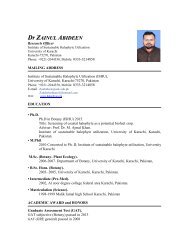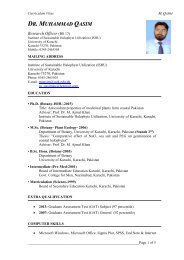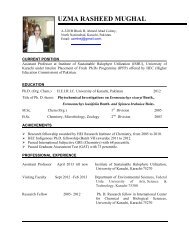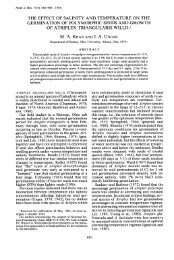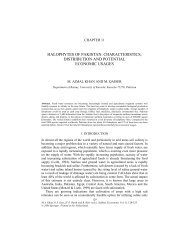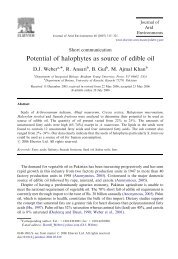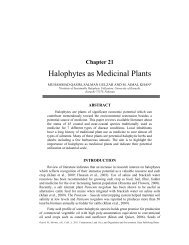Germination strategies of halophyte seeds under ... - ResearchGate
Germination strategies of halophyte seeds under ... - ResearchGate
Germination strategies of halophyte seeds under ... - ResearchGate
Create successful ePaper yourself
Turn your PDF publications into a flip-book with our unique Google optimized e-Paper software.
ARTICLE IN PRESS<br />
G Model<br />
EEB-2616; No. <strong>of</strong> Pages 15<br />
10 B. Gul et al. / Environmental and Experimental Botany xxx (2012) xxx–xxx<br />
Table 11<br />
<strong>Germination</strong> response <strong>of</strong> heteromorphic seed <strong>of</strong> <strong>halophyte</strong>s.<br />
Species Morphs Max. germination NaCl tolerance (mM) Opt. temp ( ◦ C) Reference<br />
Subtropical<br />
Arthrocnemum indicum Brown 100 1000 10/30 Khan and Gul (1998)<br />
Black 90 800 10/20<br />
Halopyrum mucronatum Brown (lighter) 100 300 20/30 Khan and Ungar (2001)<br />
Black (Heavier) 100 300 25/35<br />
Temperate moist<br />
Atriplex centralasiatica Brown 100 480 20/30 Li et al. (2011)<br />
Black 90 240 20/30<br />
Atriplex inflata Brown 98 – – Abdallah et al. (2011)<br />
Black 19 – –<br />
Atriplex prostrata Large 95 – 20/35 Carter and Ungar (2003)<br />
Small 95 – 5/25<br />
Atriplex sagittata Large 80 – 22/15 Mandák and Pyšek (2005)<br />
Medium 35 – 22/15<br />
Small 10 – 22/15<br />
Atriplex triangularris Large 100 856 5/25 Khan and Ungar (1984)<br />
Medium 100 685 5/25<br />
Small 98 342 5/25<br />
Cakile edentula Large Higher – – Zhang (1993)<br />
Small Lower – –<br />
Chenopodium album Brown (larger) 100 300 – Yao et al. (2010)<br />
Black (smaller) 10 200 –<br />
Salicornia europaea Large 99 856 – Ungar (1979)<br />
Small 61 514 –<br />
Salsola komarovii Long winged 63 514 – Yamaguchi et al. (1990)<br />
Short winged 28 171 –<br />
Suaeda salsa Brown 98 1200 – Li et al. (2005)<br />
Black 90 600 –<br />
Temperate dry<br />
Atriplex rosea Brown (larger) 100 1000 20/30 Khan et al. (2004)<br />
Black (smaller) 100 1000 20/30<br />
Salsola komarovii Large Higher – – Takeno and Yamaguchi (1991)<br />
Small Lower – –<br />
Suaeda acuminata Brown 95 – 20/35 Wang et al. (2012)<br />
Black 7 – 20/35<br />
Suaeda aralocaspica Brown (larger) 90 1400 10/25 Wang et al. (2008)<br />
Black (smaller) 40 400 10/25<br />
Suaeda moquinii Brown (s<strong>of</strong>t) 100 1000 5/15 Khan et al. (2001a,b,c)<br />
Black (hard) 90 600 5/15<br />
Suaeda splendens Brown 37 900 5/15 Redondo-Gómez et al. (2008)<br />
Black 94 600 5/15<br />
Tamarix ramosissima Spring 90 600 – Yan et al. (2011)<br />
Summer 90 800 –<br />
induce dormancy, have no effect or may increase germination in<br />
comparison to the non-treated control (Khan and Gul, 2006).<br />
5.1. Subtropical habitats<br />
Halophytes from this region are generally not tolerant to salinity<br />
when stored <strong>under</strong> saline field conditions (see Section 3.1);<br />
however, some <strong>of</strong> them show higher germination when transferred<br />
from highly saline condition to low or no salt conditions<br />
(Table 10). Arthrocnemum macrostachyum, Zygophyllum simplex and<br />
Chenopodium glaucum <strong>seeds</strong> when exposed to high salinity for<br />
20 days and then transferred to distilled water showed higher<br />
germination than untreated seed which were germinated in distilled<br />
water only (Khan and Ungar, 1998b; Rubio-Casal et al., 2003;<br />
Xue-hua et al., 2011), showing 138, 100 and 200% salt induced<br />
stimulation in germination. This effect is analogous to osmo/halopriming.<br />
In species such as Suaeda fruticosa and Limonium stocksii,<br />
salt priming had no effect (Khan and Ungar, 1997a; Zia and Khan,<br />
2004). While seed germination <strong>of</strong> Salsola imbricata, and Sporobolus<br />
ioclados after osmopriming were lower than the germination<br />
in water (Khan et al., 2002a; Khan and Gulzar, 2003; Mehrunnisa<br />
et al., 2007), showing ionic influence <strong>of</strong> salt on germination.<br />
5.2. Temperate moist habitat<br />
Most <strong>of</strong> these species after dispersal are exposed to highly saline<br />
and cold soil solutions and remain in a fully imbibed condition<br />
through winter; they germinate during early spring when the temperature<br />
begins to rise (Ungar, 1995). Although a large number <strong>of</strong><br />
<strong>seeds</strong> germinate after storage <strong>under</strong> laboratory conditions, their<br />
germination is lower than those which were not exposed to harsh<br />
saline conditions (Ungar, 1995; Keiffer and Ungar, 1995; Khan and<br />
Ungar, 1997a).<br />
<strong>Germination</strong> <strong>of</strong> some species may even be stimulated when<br />
soaked <strong>under</strong> highly saline conditions suggesting priming <strong>of</strong> these<br />
<strong>seeds</strong> by salts (Wetson et al., 2008; Elsey-Quirk et al., 2009; Li et al.,<br />
2011). The conditions to which <strong>halophyte</strong> <strong>seeds</strong> are exposed after<br />
dispersal (the storage conditions) also play a role in the subsequent<br />
seed germination (Wetson et al., 2008) and recovery from high temperature<br />
and salinity stress (Khan and Ungar, 1997a), although this<br />
response may be highly variable between species (Khan and Ungar,<br />
1999). Salt stimulation due to osmopriming may be as high as 200%<br />
in comparison to control in Chenopodium glaucum (Table 6) while in<br />
some species there was no effect and in still some others, inhibition<br />
up to 32% compared to non-treated control was observed (Table 6).<br />
5.3. Temperate dry habitat<br />
<strong>Germination</strong> increase due to salt priming can reach from 11<br />
to 26% in comparison to control (un-primed <strong>seeds</strong>), but in most<br />
species there is an inhibition compared to control ranging from −6<br />
to −87% (Table 6). In a number <strong>of</strong> species such as Triglochin maritima<br />
(Khan and Ungar, 1999), Lepidium latifolium and Peganum harmala<br />
Please cite this article in press as: Gul, B., et al., <strong>Germination</strong> <strong>strategies</strong> <strong>of</strong> <strong>halophyte</strong> <strong>seeds</strong> <strong>under</strong> salinity. Environ. Exp. Bot. (2012),<br />
http://dx.doi.org/10.1016/j.envexpbot.2012.11.006


